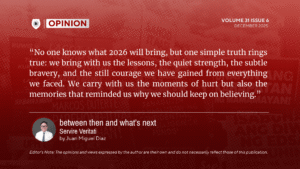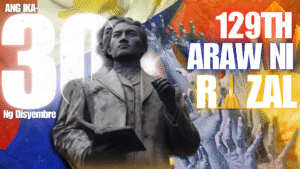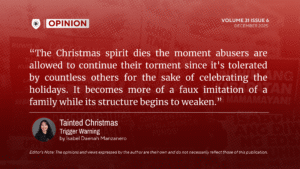Written by Angela Marie B. De Leon | August 21, 2025

Graphic Art by Louise Margareth T. Mansing
Of the people, by the people, and for the people
“THOUGH He (God) slay me, I will trust him,” said former Senator Benigno Ninoy S. Aquino Jr. in a Christian TV program in Washington, Virginia, where he was a guest before leaving to return to the Philippines. In a nation that was once built through the people’s power, the death of Ninoy Aquino is a reminder to Filipinos of how the country was built with peace and patriotism rather than arms and hatred.
Under Republic Act No. 9256, it declaresAug. 21 as the annual celebration of Ninoy Aquino Day. It is to commemorate his death anniversary and a day for Filipinos to look back on how Aquino fought for the democracy that we now enjoy.
A glimpse of the future
Benigno Aquino, Jr., also known as Ninoy, started his career as a journalist and later on entered the world of politics. In 1967, he was elected senator, which was considered a triumph for the opposition. Aquino was known for his progressive ideas, making him popular and unique in the eyes of the public. However, his progressive ideas led him to be an eyesore to former President Marcos Sr. when he became a frontrunner for the presidential elections in 1973.
Around 1968, Ninoy revealed on the Senate floor the Jabidah Massacre that was allegedly orchestrated by Pres. Marcos, Sr. It started when Marcos, Sr., secretly started a hideout and authorized a certain Major Eduardo ‘Abdul Latiff’ Martelino as the project head. Specially trained young Muslims were recruited with the promise to be enlisted in an army elite corps. However, due to unknown reasons, the training venue changed, and the recruits started to experience harsh camp conditions and starvation, pushing them to rebel. With uncertainties about its actual reason, the remaining Moros were executed by a firing squad. The lone survivor, Jibin Arula, stands to be the witness represented by Aquino.
Such an event was rumored to be one of the reasons for the continuous Moro insurgency until this day.
The lit of a matchstick
With the declaration of martial law on Sept. 23, 1972, Ninoy was arrested and in confinement for more than seven years. He was sentenced to death by firing squad in 1977. However, the unending uprising by the people saved Ninoy from his execution, and was even allowed to run in the 1978 elections behind his cell only to be rigged by Marcos Sr. His dictatorship was too blatant and evident, earning a great amount of disgust from Filipinos.
Because of his heart attack during imprisonment, he was allowed to have his heart surgery in the United States. The lifting of martial law in 1981 put Ninoy’s desire for democratic restoration more ablaze, and his plan to run for presidency re-emerged once again. His supposed-to-be victorious return ended in a flash when he was assassinated right after he set foot in the tarmac on Aug. 21, 1983. This earmarked what ignited the Filipinos to revolt.
Not long after his death, a movement named JAJA, or Justice for Aquino, Justice for All, was led by former Sen. Jose Diokno, who was also arrested in the 1970s. This movement united the community, from the middle class to the politicians and technocrats who once took part in the martial law regime. Indeed, his funeral became the Filipinos’ birthplace for rebellion.
To die for
“The Filipino is worth dying for,” famous words that Ninoy engraved to Filipinos. May this day be a moment of commitment from everyone in safeguarding the democracy that was once almost stolen from us.
Ninoy Aquino Jr.’s assassination may be one of the reasons that sparked the People Power Revolution, but what set everything in motion is the people’s will to set Filipinos free from the shackles they were once locked into.
Volume 31 | Issue 2



